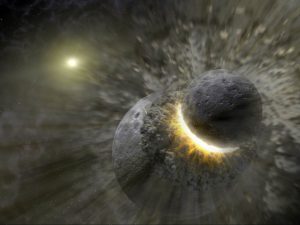
- Cet évènement est passé.
New Ideas for the Origin of the Moon
28 janvier | 15h00 – 16h00
Erik Asphaug – U. of Arizona

Twenty years ago, Moon formation seemed to be all but explained as a collision between proto-Earth and a wayward Mars-sized planet « Theia. » The velocity had to be dynamically slow, two planets falling towards each other gravitationally; but this would still be twice the speed of sound in rocks, causing shocks to propagate throughout both planets, leading to widespread melting. Most of Theia was accreted by the Earth, flinging out a molten disk into orbit from which the Moon would form. This was a very successful theory for some time. However, according to detailed 3D simulations, the lunar-forming disk would have been composed mostly of Theia’s mantle rocks, which should be noticeably different in their elemental isotopic composition from Earth’s rocks. But lunar rocks are nearly identical to Earth rocks, isotopically. This has led to a complete dismantling of the standard theory, and the formulation of at least a dozen new competing theories, some that salvage the standard model, others that are novel and extraordinary, each involving a kind of giant impact (or impacts) of some kind. In this talk I’ll put these ideas, including my own pet favorite, the « hit-and-run-return », in the context of planet formation, diversity, and habitability.
